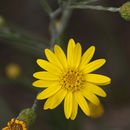Comments
provided by eFloras
The varieties can be difficult to distinguish in this highly variable species. The infraspecific classification presented by J. C. Semple and F. D. Bowers (1985) is followed here. Involucre height increases somewhat with age, making assignment of post flowering specimens of var. tenuifolia (diploid), var. latifolia (tetraploid), and var. tracyi (hexaploid) more difficult. Data on the distribution of diploids, tetraploids, and hexaploids (Semple and Bowers 1987; subsequent reports) indicate that only diploids occur west of the Mississippi River, while only tetraploids are known in the more northern parts of the range (n Alabama, Tennessee, North Carolina, Virginia). All three ploidy levels occur in Florida, where the three varieties are most distinct. Ploidy level correlates with involucre height in the limited sample of cytovouchers. Additional study is needed to sort out more fully biogeographic patterns of variation in the tenuifolia-latifolia-tracyi complex of Pityopsis graminifolia. An alternative treatment would be to combine all three in a single variety including a polyploid series, under the name var. tenuifolia.
- license
- cc-by-nc-sa-3.0
- copyright
- Missouri Botanical Garden, 4344 Shaw Boulevard, St. Louis, MO, 63110 USA
Description
provided by eFloras
Perennials, 20–80 cm; rhizomes 3–20 cm. Stems 1–5+, erect, green to brown beneath hairs, simple, silvery-sericeous (hairs irregularly anastomosing-cohering). Leaves: basal sessile, blades linear to lanceolate, grasslike, longer or shorter than cauline, 80–250(–400) × 2–20 mm, faces densely silvery-sericeous (hairs irregularly anastomosing-cohering); cauline 20–60, sometimes crowded, spreading to ascending, linear or lanceolate to ovate, usually reduced distally, apices acute, faces silvery-sericeous; distalmost sometimes greatly reduced. Heads (2–)10–100+, in corymbiform to sometimes paniculiform arrays. Peduncles 1–10 cm, sericeous; bracts and bracteoles 3–20, appressed, often grading into phyllaries. Involucres turbino-campanulate, 5–13 mm (usually shorter than pappi). Phyllaries in 4–6 series, margins fimbriate, piloso-ciliate, faces sparsely to moderately pilose (hairs often twisted), often more densely so distally, sometimes stipitate-glandular. Ray florets 9–13; laminae 4–14 mm. Disc florets 15–50; corollas 4–9 mm, limb bases glabrate to sparsely pilose or rarely limbs moderately long-pilose; lobes 0.5–0.8 mm, glabrous to sparsely pilose. Cypselae fusiform, 2.5–4.5 mm, strigose; pappi: outer scales 0.4–0.9 mm, inner 25–45 bristles 5–9 mm.
- license
- cc-by-nc-sa-3.0
- copyright
- Missouri Botanical Garden, 4344 Shaw Boulevard, St. Louis, MO, 63110 USA
Synonym
provided by eFloras
Inula graminifolia Michaux, Fl. Bor.-Amer. 2: 122. 1803; Chrysopsis graminifolia (Michaux) Elliott; Heterotheca graminifolia (Michaux) Shinners
- license
- cc-by-nc-sa-3.0
- copyright
- Missouri Botanical Garden, 4344 Shaw Boulevard, St. Louis, MO, 63110 USA

